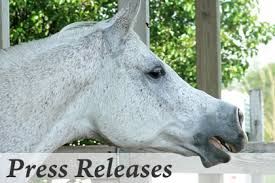Philanthropic support gives Leatherdale Equine Center new standing CT and NICU
August 20, 2019 — The University of Minnesota College of Veterinary Medicine’s (CVM) Leatherdale Equine Center (LEC) has recently acquired a new equine standing computed tomography (CT) and neonatal intensive care unit (NICU). These new additions, made possible by a generous gift from Louise Leatherdale, will elevate the level of care offered by LEC on multiple levels.
The standing CT, called Equina and developed by Asto CT, has already increased LEC’s imaging capabilities significantly. With the new CT, CVM veterinarians can quickly identify injuries to the head, neck, and legs without putting their patients through the stress of anesthesia. In addition to diagnosing head, neck and limb injuries, the CT can be used for full-body imaging of sedated foals and ponies to provide a three-dimensional perspective of areas such as the spine and pelvis. The CVM’s Equina is only the second up-and-running installation of the tool in the world.
“Having a standing CT allows us to more thoroughly image areas of the horse that we could only previously do with them under anesthesia,” says Troy Trumble, DVM, PhD, associate professor in the Department of Veterinary Population Medicine. “For our clients, this technology will allow us to definitively diagnose lesions of the lower leg and head that we could not diagnose in the past, such as stress fractures. In addition, it allows us to develop better treatment strategies and prognoses since we will know the exact location and extent of injury better, allowing us to develop better surgical plans, especially for lower leg fractures or head and teeth issues, where the exact configuration or extent of injury is hard to define on traditional x-rays.”
The new NICU, which was also included in Leatherdale’s gift, will allow CVM veterinarians to better offer around-the-clock care to sick and injured newborn foals. The unit is set up with a large mare stall and a smaller, padded stall for the foal. The two stalls are connected, with a sliding divider in place for use when the mare and foal need to be separated
Create a free account with TheHorse.com to view this content.
TheHorse.com is home to thousands of free articles about horse health care. In order to access some of our exclusive free content, you must be signed into TheHorse.com.
Start your free account today!
Already have an account?
and continue reading.
Written by:
Press Release
Related Articles
Stay on top of the most recent Horse Health news with









